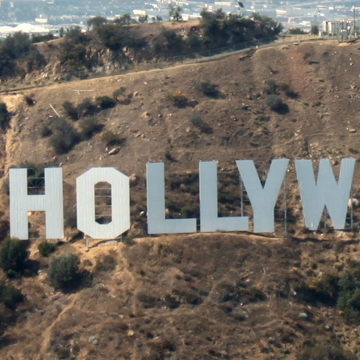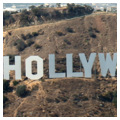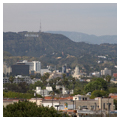In a 1987 letter to the Los Angeles Times, Duke Russell compared the Hollywood Sign to the Eiffel Tower and the Brooklyn Bridge, upset that the City of Los Angeles was considering selling more licenses for commercial shoots involving the iconic sign. But unlike the other monumental structures he listed, the Hollywood Sign’s history had wholly commercial origins and humbler associations. Though today the Sign symbolizes greater Los Angeles’s sense of place, its original 1923 purpose was to promote the sale of a few parcels of land. Real estate titan and Los Angeles Times publisher Harry Chandler commissioned sign-maker Thomas Fisk Goff to design this ambitious hillside billboard reading “Hollywoodland” to draw attention to a tract development in the hills below (located just north of downtown Hollywood). Every night for fifteen years, fifty-foot-tall bright white letters projected light from 4,000 twenty-watt bulbs, which flashed the word in three parts, Holly...Wood...Land…, followed by a final flash of all the letters at once. The company, having sold its properties by 1944, dissolved and transferred ownership of the Sign’s site to the city government. Few could have anticipated that the Sign or the Beachwood Canyon neighborhood below would become iconic.
Salesmen S.H. Woodruff and Tracy E. Shoults produced a series of maps and books to promote empty lots to potential buyers. Woodruff’s map suggested the Sign might draw attention, but the list of Hollywoodland’s advantages would sell the houses. Modern urbanism was part of the draw. Public utilities included aqueduct water, sewers, and concrete paving, which would all be guaranteed provisions by the city. Distances to other destinations were measured not in miles but instead in units of time: “30 minutes from downtown Los Angeles,” “5 minutes from the center of Hollywood.” This neighborhood’s imagined residents would own and operate automobiles. Available here was the vaguely defined “Freedom of the Hills,” which meant in part that the residents’ children would be safe and “free from the menace of crowded boulevards.” A limitation to that freedom was a zoning rule instituting “architectural and general restrictions for fifty years,” which would protect “your view” and “insur[e] artistic homes without excessive cost.” Hollywoodland was a place where no mansions would threaten to reduce less affluent residents’ status. But the same restrictions would also prevent any vertical developments that might include apartment housing or commercial sites—precluding both working-class residences and places of employment. This common middle class would collectively mature into affluence as Hollywoodland was situated so that “homesites purchased today will be worth fortunes.”
Shoults’s more extensive brochure made no mention whatsoever of the Sign. Shoults imagined the neighborhood would have a higher-class atmosphere with “winding boulevards...lighted with ornamental street lamps.” With Griffith Park so nearby, residents could expect to forever enjoy “the scenic beauties of Nature’s gift to California.” An architectural committee had to approve plans for housing designs. “It is not the desire...to place any difficulties in the way of individual expression, but...in the interests of all it is necessary to see that every home conform to a scheme of architectural beauty.” The irony of these grand ambitions is the enduring legacy of the Hollywoodland Sign itself, which represented a rather crass relief to the high-quality houses and roads snaking up lush canyons below. But preservation and ornamentation were goals the developers placed second to their need to keep selling tracts until there were none left. A review of promotional photographs of the Spanish and English Tudor–style houses and the neo-Gothic entryway to the site only once includes the Sign, in the background peeking from behind a ridge. Similarly, author Nathanael West never made mention of this Sign in his 1939 novel, The Day of the Locust, set in the Beachwood Canyon neighborhood.
In 1949 the Hollywood Chamber of Commerce tore down the “land” portion of the Sign, leaving the detritus in a heap adjacent to the remaining letters. Journalist Bob Johnston noted the Sign’s growing precarity in the 1970s. While the letters retained their look from afar, seeing the Sign up close revealed the thin metal letters to be “breached, torn and bent. Most are streaked and stained in a spectrum of rust colors...Don’t get too close.” In 1973 the Sign officially became a Cultural Historic Monument, but this new status must not belie the degree to which the Sign retained the character of a commercial venture. By 1978, the Hollywood Chamber of Commerce raised enough money to refurbish the Sign and place it in the care of a trust, which charged fees for commercial photography or filming. Arco Solar Incorporated offered in 1988 to renew the lighting as part of an effort to promote solar energy, with parent company Atlantic Richfield retaining the right to use the Sign in branding efforts. Residents demurred all plans of this kind. Remembering the Sign’s temporary lighting during the 1984 Olympic Games, Gladwin Hill described “gawkers” congesting the streets. The plan failed after over a thousand Hollywoodland residents signed a petition in opposition. By 1991, Mayor Tom Bradley decided to rehabilitate the Sign, transferring care of it (and the Walk of Fame) to the Los Angeles Department of Recreation and Parks, which proposed guidelines to protect it and its natural environment. But even these restrictions could not quiet the nerves of Hollywoodland’s residents, who feared disturbance from helicopters filming the Sign above their residential neighborhood.
In her 1972 ballad, “Mary C. Brown and the Hollywood Sign,” singer-songwriter Dory Previn sang, “I doubt if the Statue of Liberty ever welcomed more refugees.” Recounting the tragic story of a failed actress who leapt off the Sign’s “H,” the song helped encode meaning in both this object and the industry it signified. Historically, refugees flocked to Hollywood, particularly Jewish refugees fleeing Eastern European pogroms and congested East Coast U.S. cities. The suggestion that the Hollywood Sign’s appeal might reside in its role as a beacon to hopeful filmmakers is provocative. Los Angeles signage has had a tendency toward the overt and gaudy. But this piece of unintended architecture fits well within the forces that made the region one of the first where designers experimented with Googie design. By the 1960s, this imagery inspired Pop artist Edward Ruscha to reproduce the Sign as fine art. Critic Reyner Banham concluded from Ruscha’s choices of subject matter that the artist’s gas stations, parking lots, and the Hollywood Sign altogether were “worth looking at.”
References
Banham, Reyner. “Under the Hollywood Sign.” In Edward Ruscha: Prints and Publications, 1962-1974. London: Arts Council of Great Britain, 1975.
Bradley Administrative Papers, Collection 293, boxes 186, 1897, and 4933, UCLA Library Special Collections, Charles E. Young Research Library, University of California, Los Angeles.
Gabler, Neal. An Empire of their Own: How the Jews Invented Hollywood. New York: Anchor Books, 1988.
“Hollywood Sign.” Hollywood Sign Trust. Accessed February 8, 2016. http://hollywoodsign.org/.

















